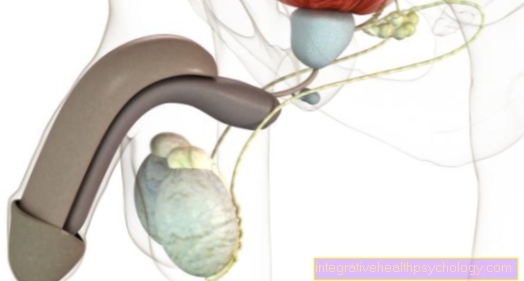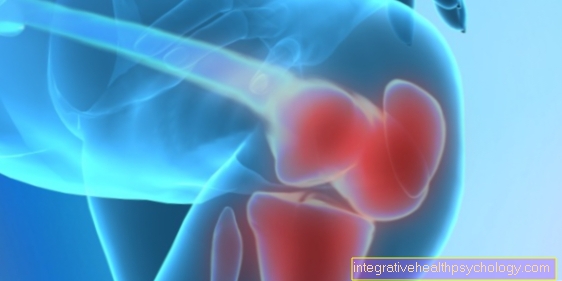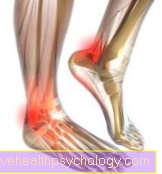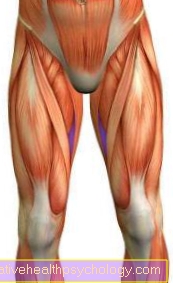Inguinal hernia in the baby
definition
An inguinal hernia is a hernia that manifests itself in the groin area. However, this is not actually a break, as no bones are involved.
Rather, increased pressure conditions in the abdomen (such as coughing) lead to the fact that viscera can protrude through the body's own non-closed openings or weak points in the tissue.
The inguinal hernia can then be visually recognized by a palpable protrusion, which can cause almost all symptoms, from pushable to extremely painful.
Read more on the topic: Inguinal hernia

Causes of an inguinal hernia
The most common cause of an inguinal hernia in babies is a developmental gap in the peritoneum that has remained open.
This can be explained well by the development of the testicles in boys.
The testicles first develop in the abdominal cavity and then migrate down into the scrotum as the baby grows. The peritoneum moves down with it as its protective covering. Normally, the opening of the peritoneum above the inguinal canal closes by itself before the birth until a short time afterwards. If the closure does not take place, organs and especially parts of the intestine can also get out of the abdominal cavity via the groin and into the scrotum.
This explains the term hernia or inguinal hernia. The downward migration of parts of the intestine is particularly favored by the increased pressure in the abdomen. Examples of this would be coughing, sneezing or pressing hard when defecating.
The earlier the baby is born, the higher the risk of an inguinal hernia. If it does not have the normal development time in the womb, not all maturation processes and thus also the closure of the peritoneum above the groin cannot be completed. Very unusual in babies is the rupture of tissue at the body's own weak points, as is often found in adults in the groin area. Babies, however, do not strain themselves physically like adults and do not lift heavy loads either, so this cause is a rarity.
You might also be interested in: Causes of an inguinal hernia
How dangerous can a hernia be in babies?
In principle, a hernia is not a life-threatening disease for a baby. Only when the hernia leads to an impairment of the baby is it to be regarded as immediately dangerous. However, it should be treated surgically to avoid complications.
The greatest risk of an inguinal hernia is the irreversible entrapment of the intestines, which in the worst case leads to the death of the affected intestine.
If irreversible entrapment is not treated, the reactive inflammatory reaction will eventually lead to the dissolution of the intestinal mucosa. In the extreme case, the intestine can even tear at this point.
As a result, stool then leaks into the abdominal cavity and leads to generalized inflammation. This is very stressful for a baby and carries the risk of a life-threatening circulatory disorder. In such cases, quick action is indicated. The only cure then promises an emergency operation with the removal of the affected intestinal parts.
Diagnosing an inguinal hernia
The diagnosis of an inguinal hernia is primarily made through the physical examination. Usually a typical bulge appears in the groin area, which can be felt as a soft protrusion.
Depending on the severity of the hernia, the bump can be pushed away completely or not at all. If the protrusion is not visible, the parents often report it during the anamnesis. Characteristically, according to the descriptions, it occurs during strong crying, screaming or pressing. In these cases, a protrusion can usually also be provoked by the examiner. If the diagnosis is uncertain despite the physical examination, an ultrasound can help to visualize parts of the intestine in the groin area or scrotum.
How can you recognize an inguinal hernia in the baby yourself?
It is best to take a close look at your baby as he grooms. If a bump is visible in the groin area, a hernia is suspected.
It doesn't matter how big the bump is. It can vary in size from the size of a marble to an egg. Once the bump has been observed, it is important to also pay attention to when the bump occurs and whether it is permanent.
Parents shouldn't try to push the bump away on their own when you first notice it. If there are still additional symptoms, the risk of additional injury is higher than helping the baby. Placing the fingers lightly allows only the consistency of the bump and the skin temperature to be felt.
What are accompanying symptoms of an inguinal hernia?
Accompanying symptoms depend on the severity of the hernia. The more intestines are constricted in a tissue covering such as the inguinal canal, the more likely it is that the body's own structures are damaged.
In the best-case scenario, the viscera prolapse occurs only in phases and the viscera pull themselves back into the abdomen. In these cases, the baby is only in pain when the bump occurs, if any.
If parts of the intestine are permanently constrained, this can mean a disturbed digestion. The lumen of the affected intestine is then narrowed so much that food pulp cannot pass through this section, or only with difficulty.
As a result, the intestinal contents build up in front of the constriction and painfully expand the unaffected intestine. As a result, babies stand out for their whimpering behavior and persistent crying. In addition, there may be a reluctance to drink. If the intestine is squeezed so severely that even the blood vessels are tied off, if not treated, the intestine will die.
In babies, this leads to the greatest pain and, with increasing extent, is also visually visible from the outside. The bump gradually takes on a red to slightly purple color with the increasing undersupply of the intestinal parts.
Any painful redness in combination with a bump in the groin should therefore be seen as a warning signal.
You might also be interested in: Symptoms of an inguinal hernia
Pain as an accompanying symptom of an inguinal hernia
In the case of an inguinal hernia, pain is mainly caused by pinched viscera. To be precise, it is nerve endings in parts of the intestine that are irritated. If the pressure on the tissue at the constriction increases, nerve fibers are compressed.
The affected person experiences pain as an effect. But it can also be that the pain is caused by excessively distended intestinal parts. If intestinal contents accumulate in the area in front of the constriction, more gases are reactively produced by intestinal bacteria there. Too much stretching of the mucous membrane also causes irritation of sensitive nerve fibers. This also leads to the sensation of pain.
Read more on the topic: Pain in an inguinal hernia
Surgery for a baby's hernia
An operation is always the only curative measure for an inguinal hernia.
Conversely, this also means that no medication or bandages can repair an inguinal hernia. The principle of every operation is to close the passage point for the viscera. Which method is chosen depends on the type and severity of the hernia. Since a gap in the peritoneum is often the cause of the hernia in babies, this gap is surgically closed with a thread.
This type of closure is completely sufficient. Use of a net is sometimes required in adults, but contraindicated in children. In the case of children, the principle applies, if possible, not to introduce any foreign bodies that could later impair their growth.
Nowadays, the minimally invasive technique is the standard. In technical terms, this is also known as a laparoscopic procedure. For this purpose, instruments are introduced into the abdominal cavity using several small skin incisions. A camera introduced with enables an exact reflection of the abdominal cavity and allows the instruments to be observed well.
The advantage of this method is that the small cuts heal quickly and only leave very narrow scars. In addition, the entire abdominal cavity can be viewed if necessary and further complications recognized or treated directly.
If minimally invasive surgery is contraindicated, an open approach can of course also be chosen. Although it means a larger skin incision, the general procedure of the operation is the same. It is up to the surgeon to weigh up which technique is most useful for the little patient.
You might also be interested in: Surgery for an inguinal hernia
Risk of hernia surgery in the baby
The risks of the surgery of an inguinal hernia result from the physical characteristics of a baby. The small lung volume and the risk of heat loss are special challenges for the anesthesia performed by the anesthetic.
With surgery, the risks are similar to those in adults. In rare cases this can lead to damage to other structures or secondary bleeding. In boys, there is also a particular risk that the spermatic cord may be severed, which, however, is optimally avoided through the intraoperative exposure of the spermatic cord.
Anesthesia in the baby
Anesthesia in babies is basically similar to anesthesia in adults. The aids used for monitoring and short-term ventilation are almost the same and only differ in size.
Medicines are also administered according to their size and weight. The anesthesia generally represents a risk, but it can be minimized by the planned hernia surgery.
In most cases, a hernia can be carried out the next day after extensive education and planning. The feeding times can thus be optimally adjusted and risks can be kept as low as possible.
As an alternative to anesthesia, local anesthesia using spinal anesthesia can also be considered. However, this must be differentiated from the practitioner in each individual case.
Duration of healing
The healing depends on the selected surgical procedure. Nowadays, the minimally invasive technique is the standard in German hospitals. The small cuts usually heal within a few days to a week.
The inner sewing of the break point is directly stable through the thread.
Since no further damage to the tissue was caused by cuts, only minimal wound healing needs to take place in the area of the suture. For parents, this means that they can deal with their baby as usual after the operation. Only the external wounds should be adequately treated and covered.
How long does the baby have to stay in the hospital?
It is generally at the discretion of the practitioner which length of stay he considers appropriate for the baby in the hospital. Depending on the complications and the course of wound healing, the length of stay should always be weighed up with the parents on a case-by-case basis. If the operation was uncomplicated and the anesthesia without any special features, there is usually nothing to prevent an otherwise healthy baby from being discharged after two to three days.
This period is required, however, if a possible excess of medication and complications such as secondary bleeding are to be safely excluded.





























